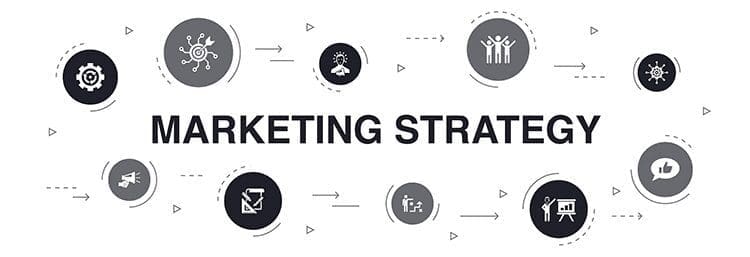Are you looking to create or update your company’s B2B marketing strategy? Not sure where to start, or what the best practices are? You’re in luck – this post will cover everything you need to know about B2B marketing strategies. We’ll go over the different components of a successful strategy, key trends to be aware of, and actionable steps you can take today to improve your plans. Whether you’re a seasoned marketing professional or just getting started, this post will give you the insights you need to craft a winning B2B marketing strategy. So let’s get started!

Establish Brand Culture and Values
The first step to crafting a successful B2B marketing strategy is establishing your brand culture and values. This means looking closely at the company’s mission statement, its core target market, and what type of message you want to convey to customers. Your brand culture should be reflected in all aspects of your business, from customer service to advertising materials.
Conduct Market Research
Before diving into any form of B2B marketing, it’s important to have a thorough understanding of your target audience and potential customers. Conducting market research will help you gain insights. Who your ideal customer is, how they think and behave, and which channels are most effective for reaching them. Armed with this data, you’ll be able to create more tailored, effective campaigns.
Defining your audience – who are you marketing to and what do they need/want from you?
A successful B2B strategy starts with audience definition. You need to know who you are marketing to, what they want and need from you, and why they care about your product or service. It’s important to keep in mind key audience trends – do they prefer video or text-based content? What channels do they use most often? Now more than ever, understanding your audience is essential in order to create engaging messaging that resonates.
As a first step review your customer data in order to find out what kind of people you’re dealing with. What’s their age, location, interests etc. Use that info as the foundation for audience segmentation. This will point you in the right direction when crafting relevant and helpful customer experiences. Also, what are the pain points that you and your organization solve? That way, every actionable step you take towards creating a strong B2B marketing strategy will align with audience wants and needs.
Research your competition – what are they doing that’s working, and how can you improve upon it?
Researching your competition is a powerful way to stay in the know. It also helps with the ever-changing landscape of B2B marketing. It’s important to understand not only what they’re doing that is helping them succeed, but also the trends that are emerging and evolving in the industry. With this research, you can begin to refine your strategy and gain insight on how to further improve upon it. The goal is always to keep up with, or better yet stay ahead of, your competitors. Also to position yourself for success. By analyzing their tactics, trends, and successes you can identify what works best for you. It’ll help you hone in on actionable steps needed to review, adjust, and prune your current plans accordingly.
Developing your messaging – what is your unique selling proposition and how will you communicate it to your target audience?
Developing messaging for your business can seem overwhelming, especially when it’s coming from multiple departments. The key to any form of messaging is integration. It starts with knowing what your unique selling proposition (USP). This is so you can effectively communicate that to your target audience. To uncover the right messaging, look at current B2B strategies and trends. Make sure your messaging remains consistent between each touchpoint of communication. Reviewing your messaging regularly ensures the delivery of the right message at the right time. In doing this, it will help you better reach, engage and acquire your target audiences.
Creating content that resonates – what kind of content will resonate with your target audience and help you achieve your goals?
Crafting content that resonates with your target audience can be a tricky task, but it is key to helping you achieve your business goals. While developing a strategy for your content marketing should start with knowing and understanding your target audience. In addition to delivering relevant content, every great content plan should address current trends and the overall value of content. Some actionable steps to go through while creating content that resonates includes several things. Researching topics, asking key stakeholders questions, sorting content into categories based on customer intent, and ensuring the content offers unique value. This will help you create content that will leave a lasting impression on your intended target audience.
Promoting and distributing your content
How will you get your content in front of the right people at the right time?
Promoting and distributing your content is key to getting your message out there and engaging with the right people. Finding the best marketing channels can be difficult, given the amount of options available today! However, exploring different technologies that promote and distribute digital marketing content like social media marketing and email campaigns can be a great place to start. Additionally, staying up-to-date on search engine optimization (SEO) practices will help reach more people since SEO is an ever-changing landscape. Crafting message consistently across all these channels (integrated marketing) is essential when mapping out your strategy. Ensuring correct message sequencing, use of visuals and tone of voice are all important considerations.
Other elements of your digital marketing campaigns can also include marketing automation software. What are things that you can automate especially with reduced marketing team? Using technology can get your message out quickly and be tailored to who’s receiving it.
Once you have both traditional and digital marketing components (marketing mix) in place, it’s time to review your plans and get started on your marketing efforts!
Measuring success
How will you know if your B2B marketing strategy is successful. What metrics will you use to track progress over time?
It’s essential to measure the success of a B2B marketing strategy, so you can identify what is working and adjust your plans over time. Using metrics and analytics to track progress is an invaluable way to measure success. Data metrics such as website engagement, inbound leads, sales conversions, ROI metrics and CRM measures should all be taken into account when assessing success. It’s also important to build internal key performance metrics for brand awareness campaigns, so you can effectively review results and adjust your strategy accordingly. With a comprehensive strategy incorporating leading tactics, key trends and actionable steps around metrics, you’ll have the information you need to know if your B2B marketing strategy is truly successful.
The major B2B marketing trends for 2023
The B2B marketing landscape is shifting rapidly as technology advances and customer expectations evolve. As such, understanding the latest trends in this space is essential to staying ahead of the curve. Some major B2B marketing trends for 2023 include:
- Personalized content
- Integrated campaigns across multiple channels
- Leveraging AI-powered technologies like chatbots and virtual assistants for customer engagement
- Using customer data for targeted campaigns
- Developing a mobile-first strategy
- Focusing on online presence through social media networks
To make the most out of these trends, companies should review their current strategies to identify where they need improvement, understand their target audiences better in order to craft content tailored specifically towards them and use AI-powered technologies to better engage with customers.
Influencer marketing was the trend leveraged most this year.
Influencer marketing has become a powerful tool in the B2B marketing space. As brands rely on influencers to reach new and loyal audiences. This type of marketing can help businesses increase their online presence, create more meaningful engagement with customers and ultimately boost sales. In 2021, influencer marketing was one of the most popular trends for both B2C and B2B companies. As marketers leveraged influencers to gain trust from potential customers and build relationships between brands and their target audiences. Additionally, many companies also adopted sponsored content strategies featuring influencers and harnessed user-generated content from social media platforms to further promote their business. Link building is also a part of this.
Conclusion
By understanding leading B2B tactics, staying up-to-date on the latest trends and measuring success through data metrics, you can create a successful B2B marketing strategy that will maximize engagement and drive results and offer solutions to your audiences’ pain points. Using these key tactics will help ensure your approach is effective in reaching the right people at the right time. It will also help solidify your brand’s presence in today’s competitive market! With this comprehensive knowledge of best practices for creating a successful strategy, you are now ready to take on any challenge that comes your way!
If you have any additional tips based on your experience, please share them in the comments – I’d love to hear from you!


